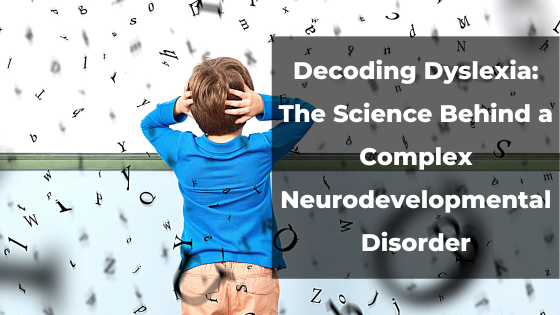
Dyslexia is a problem faced by more than 2.8 million school-aged children. Sadly, this neurodevelopmental disorder is an often-misunderstood, confusing term used to describe reading problems.
One of the most common misunderstandings about this condition is that dyslexia is a problem of letter or word reversals[1] (b/d, was/saw) or of letters, words, or sentences “dancing around” on the page.
The truth is that writing letters and words backward is common in the early stages of learning to read and write and may, or may not, indicate an underlying reading disability.
One of the most complete definitions of dyslexia comes from decades of research:
Dyslexia is a specific learning disability that is neurobiological in origin. It is characterized by difficulties with accurate and/or fluent word recognition and by poor spelling and decoding abilities. These difficulties typically result from a deficit in the phonological component of language that is often unexpected in relation to other cognitive abilities and the provision of effective classroom instruction.[2]
Dyslexia is a specific learning disability affecting 80% of all those designated as learning disabled. It is a common neurodevelopmental disorder, meaning that the problem is located physically in the brain.
As a reminder, we now know that dyslexia is not caused by poverty, developmental delay, speech, or hearing impairments, or learning a second language, although those same conditions may put a child more at risk for developing a reading disability.[3]
It is now estimated that 15 to 20 percent of children are affected by dyslexia. The cases are equally split between gender and ethnic background.
Children with dyslexia most often have two obvious difficulties when asked to read text at their grade level.
- Typically, they are not able to sight-read as many words in a text as average readers. Indicators include stumbling over, guessing at, or attempting to sound out words.
- These children will often have decoding difficulties like being able to accurately understand and employ letter-sound relationships to identify unknown words.
Researchers at Carnegie Mellon, using MRI scans of the brain, discovered that dyslexia involves a part of the brain located above the left ear, between the parietal and temporal lobes.
This is the area responsible for decoding the sounds of written language. As a child learns to read by sounding out words correctly a few times, the brain should automatically transfer the word to the decoding part of its storage area. Children with dyslexia have less activity in this part of the brain than those without dyslexia.
Other supporting neuroimaging studies of individuals with dyslexia show structural and functional differences, particularly in regions such as the left hemisphere temporoparietal cortex, left occipitotemporal cortex, and their interconnecting white matter tracts.[4]
These findings suggest that dyslexia arises from impaired neural networks responsible for phonological processing and visual word recognition.
ONGOING READING CHALLENGES
With this insightful information, we must ask the question, why are dyslexia cases increasing? Some might point to class size increases and funding decreases.
Other factors include:
Genetic
Evidence from twin and family studies indicates a strong genetic component in dyslexia. Several candidate genes, such as DYX1C1, DCDC2, and KIAA0319, have been linked to dyslexia susceptibility. Dyslexia-related genetic variants influence early brain development, neural migration, and neuronal connectivity, exacerbating the risk for dyslexia. However, it is crucial to acknowledge that dyslexia is a polygenic disorder influenced by multiple genetic factors, each contributing a small effect.
Environmental
While genetics play a significant role, environmental factors can also contribute to the development of dyslexia. Prenatal and perinatal factors, such as maternal smoking, alcohol consumption, or exposure to toxins, have been associated with increased dyslexia risk.[5]
Additionally, deficits in early language exposure and impoverished reading environments can hinder the acquisition of crucial phonological and phonemic awareness skills, further impeding reading proficiency.
Diagnostic
Accurate and early diagnosis is essential for effective intervention strategies in dyslexia. Various assessment tools, including standardized reading tests, phonological awareness tasks, and working memory assessments, aid in identifying dyslexic individuals.
Intervention
Targeted interventions and evidence-based instructional methods play a crucial role in supporting individuals with dyslexia. Multisensory structured language approaches that integrate visual, auditory, and kinesthetic modalities have demonstrated efficacy in enhancing reading outcomes.
HOW TEACHERS CAN HELP
Listed below are some helpful recommendations based on this new, neurological research:
- Adequate and early assessments of language processing are important in determining why a child is having difficulty with language and reading.
We cannot emphasize enough that screening and progress monitoring procedures must be in place early on to measure a child’s understanding of sounds in speech, letter sounds in words, and fluent word recognition.
- Explicit, intense, systematic instruction in the sound structure of language (phonemic awareness) and in how sounds relate to letters (phonics) is needed for readers with dyslexia.
- Remove the fear of failing when it comes to reading problems. This isn’t a case of students not trying hard enough. Instead, provide consistent, intense intervention, with a lot of short-term goals and reward for students who are working through difficult and painful tasks.
- Focus on the strengths of students’ neurological characteristics to help them understand that they shine in so many other ways.
WHAT PARENTS CAN DO NOW
Often, the process of identifying whether a child has dyslexia is a difficult time for all involved, but here are the things that parents can do to ease the way:
- Don’t fall into the trap of common misconceptions surrounding dyslexia. Remember, that this is a neurological disorder that requires a different learning approach.
- If your child is not receiving the best in early intervention with intense, explicit language and reading instruction, find experienced teachers and schools. Look for programs and services that will ensure greater levels of success and cooperation between home and school.
- There are several organizations devoted to supporting and advocating for individuals with dyslexia. We recommend the Arizona branch of the International Dyslexia Association. or we are always happy to listen to your concerns. Contact Rockwood Prep Academy here.
- Stand up and advocate for your child. Sharing current information about brain research can help demystify dyslexia so that others realize that children with dyslexia simply process language differently than their peers.
Don’t let your student become part of that sad statistic of those who fail year-end school achievement tests. Reading disorders like dyslexia are challenges that can be met and overcome.
You’ve already started by learning how to understand the science of dyslexia and the push for early identification, evidence-based interventions, and improving educational outcomes for affected individuals.
Thankfully, ongoing interdisciplinary research, encompassing genetics, neuroscience, and neuropsychology, continues to broaden our knowledge of dyslexia, providing hope for more effective strategies in its management and support in the years to come.
Other References: American Psychiatric Association. (2013). Diagnostic and statistical manual of mental disorders (5th Ed.). American Psychiatric Publishing. Fisher, S. E., & DeFries, J. C. (2002). Developmental dyslexia: Genetic dissection of a complex cognitive trait. Nature Reviews Neuroscience, 3(10), 767-780. Fletcher, J. M., Lyon, G. R., Fuchs, L. S., & Barnes, M. A. (2007). Learning disabilities: From identification to intervention. Guilford Press. Paulesu, E., Démonet, J. F., Fazio, F., McCrory, E., Chanoine, V., Brunswick, N., Cappa, S
[1] https://pubmed.ncbi.nlm.nih.gov/26151366/
[2] https://www.scirp.org/(S(czeh2tfqyw2orz553k1w0r45))/reference/ReferencesPapers.aspx?ReferenceID=960764
[3] https://files.eric.ed.gov/fulltext/ED416465.pdf
